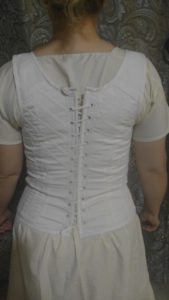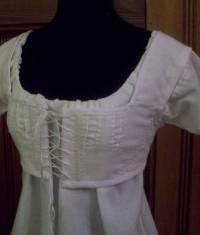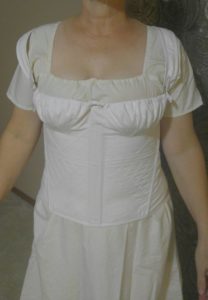 During the Regency, Corsets were called Stays. This style of stays is called long stays. This is the kind of stays nearly every women, rich or poor, wore. The material we used to make my stays was cotton twill. Later, I discovered that another good choice for stays or corsets is Coutil (or Coutille), a woven cloth created specifically for making corsets. I don’t know how authentic it is, but it has a nice, stiff feel.
During the Regency, Corsets were called Stays. This style of stays is called long stays. This is the kind of stays nearly every women, rich or poor, wore. The material we used to make my stays was cotton twill. Later, I discovered that another good choice for stays or corsets is Coutil (or Coutille), a woven cloth created specifically for making corsets. I don’t know how authentic it is, but it has a nice, stiff feel.
The cotton twill fabric is stiff and tightly woven to inhibit penetration of the corset’s boning which is called stays and what gives this garment its name. Both Twill and Coutil have a high cotton which has good dimensional stability, or a resistance to stretching, which makes it a good choice for clothing, and especially such as a stressed garment. My grommets are metal, but authentic Regency stays have stitched button holes. Some day, when I have nothing better to do, I will hand stitch around my grommets to make them look more authentic.
As you can see, I am wearing my stays over another garment called a shift, or chemise. You can read more details about it here.
 Some women preferred short stays, or demi stays. These seemed to be mostly worn during the summer or if they were especially small busted, or if they didn’t have someone to help lace up their stays—although that would have been very rare—but these provided less support and lacked the smoothing effects of the long stays so they were not anywhere near as popular. It is believed that more of the working classes wore short stays, (probably because they were thinner or because the short stays cost less) than members of the upper classes. However, many sources suggest most working women wore long stays, too. Working class women usually shared a room with someone else so there was always another pair of hands to help lace stays in back.
Some women preferred short stays, or demi stays. These seemed to be mostly worn during the summer or if they were especially small busted, or if they didn’t have someone to help lace up their stays—although that would have been very rare—but these provided less support and lacked the smoothing effects of the long stays so they were not anywhere near as popular. It is believed that more of the working classes wore short stays, (probably because they were thinner or because the short stays cost less) than members of the upper classes. However, many sources suggest most working women wore long stays, too. Working class women usually shared a room with someone else so there was always another pair of hands to help lace stays in back.
Regency corset stays are quite comfortable. They don’t pinch. It’s simply not possible. Unless the boning is working its way out, they don’t poke. Unlike Victorian corsets which can be tightly laced, Regency stays don’t make it difficult to breathe. With the exception of the mid to late 1800’s, corset stays were not designed to give women a small waist, but to lift the bustline, and to give women a smooth base for clothes. In fact, until the introduction of the metal grommet (1828) and the 2 part metal busk (1829), tightening a corset enough to dramatically change one’s figure was nearly impossible. The fabric or the holes would have given out first.
If your heroine doesn’t wear stays, the clothing won’t lay well. The corset provides the right silhouette for the loose, flowing gowns of the Regency. Even if she chooses to wear them loosely laced, she would still wear them.
While corsets are not uncomfortable, they do restrict the wearer in ways you may, and may not, expect.
 The front center of our Regency stays has a wooden busk. This is roughly the size and shape of a common school ruler. The busk is designed to help the garment lay flat, as well as lift and separate the breasts. Because of the busk, our Regency lady not able to bend freely at the waist, but will do so from the hips. The busk also encourages excellent posture. Slouching is not really an option in a long corset due to the busk.
The front center of our Regency stays has a wooden busk. This is roughly the size and shape of a common school ruler. The busk is designed to help the garment lay flat, as well as lift and separate the breasts. Because of the busk, our Regency lady not able to bend freely at the waist, but will do so from the hips. The busk also encourages excellent posture. Slouching is not really an option in a long corset due to the busk.
Now, there are a few possible discomfort factors. Other stays wearers tell me they sometimes have tiny indentations from where the shift underneath the stays has creased the skin. These may itch a little for a few minutes. Rubbing them helps, I am told, but I’ve never had this problem.
If you lose weight, your corset can become uncomfortable—more so than if you gain a bit, as your breasts may slide down and get “squashed”. Plus, if it’s loose, it may rub.
If the boning works out of the channel at the top or bottom, it can jab but that won’t happen if it’s well made.
Overall, Regency stays really are quite comfortable and nice to wear. My main gripe is how long it takes to get into them, and that I can’t do it by myself. Otherwise, I’d be tempted to wear stays every day instead of a bra.

Thank you, Donna, for these informative posts!
I, too, would prefer to wear a corset! I am a petite-but-well-endowed woman, and I have never been more comfortable than in graduate school doing opera workshops and wearing a corset while singing–in fact, it was so comfortable that I would also wear it when conducting (my primary job)–no worries about bra straps falling, the girls popping out or getting uncomfortable, and so on!
Hello…my name is Preston Hatch I’m curious of the origin of the Hatch Corset Stays. I believe it may have involved a great Uncle of my Walter Hatch. He was an inventor of things and I’m told a very brilliant man. I found a box of #2 pencells, in my Fathers belongings, that had The Hatch Corset Stays printed on the pencell. I’m just curious if you have any knowledge of the Origin of the Stays. We may also be related.
Hi Preston,
Unfortunately, I’m not well versed on Preston stays. I’ve only heard of them. That’s so exciting that you are related to them. My husband might be but he’s not familiar with them, either. It’s funny, too, because I have a nephew named Preston Hatch, but I assume you aren’t him 🙂
I wish I could be of more help. Good luck!
Thank you this is most interesting.